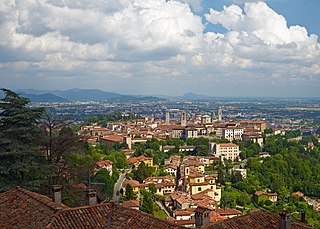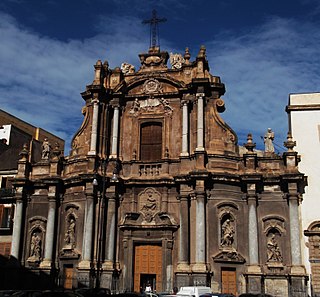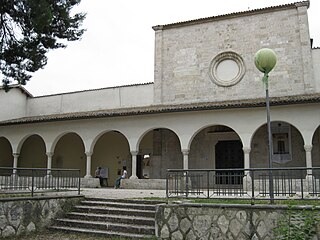
The Alhambra is a palace and fortress complex located in Granada, Andalusia, Spain. It is one of the most famous monuments of Islamic architecture and one of the best-preserved palaces of the historic Islamic world, in addition to containing notable examples of Spanish Renaissance architecture.

Marsala is an Italian comune located in the Province of Trapani in the westernmost part of Sicily. Marsala is the most populated town in its province and the fifth in Sicily.

Cusco or Cuzco is a city in southeastern Peru near the Sacred Valley of the Andes mountain range and the Huatanay river. It is the capital of the Department of Cusco and of the Cusco Province. The city is the seventh most populous in Peru; in 2017, it had a population of 428,450. Its elevation is around 3,400 m (11,200 ft).

Rimini is a city in the Emilia-Romagna region of Northern Italy.

Bergamo is a city in the alpine Lombardy region of Northern Italy, approximately 40 km (25 mi) northeast of Milan, and about 30 km (19 mi) from Switzerland, the alpine lakes Como and Iseo and 70 km (43 mi) from Garda and Maggiore. The Bergamo Alps begin immediately north of the city.

Todi is a town and comune (municipality) of the province of Perugia in central Italy. It is perched on a tall two-crested hill overlooking the east bank of the river Tiber, commanding distant views in every direction. It was founded in antiquity by the Umbri, at the border with Etruria; the gens Ulpia of Roman emperor Trajan came from Todi.

Crespi d'Adda is a village in northern Italian and hamlet (frazione) of Capriate San Gervasio, a municipality in the province of Bergamo, Lombardy. It is a historic settlement and an outstanding example of the 19th and early 20th-century "company towns" built in Europe and North America by enlightened industrialists to meet the workers' needs. The site is still intact and is partly used for industrial purposes, although changing economic and social conditions now threaten its survival. Since 1995 it has been on UNESCO's list of World Heritage Sites.

Chieti is a city and comune (municipality) in Southern Italy, 200 kilometres east of Rome. It is the capital of the province of Chieti, in the Abruzzo region.

Comacchio is a town and comune of Emilia Romagna, Italy, in the province of Ferrara, 48 kilometres (30 mi) from the provincial capital Ferrara. It was founded about two thousand years ago; across its history it was first governed by the Exarchate of Ravenna, then by the Duchy of Ferrara, and eventually returned to be part of the territories of the Papal States. For its landscape and its history, it is considered one of the major centres of the Po delta.

Casale Monferrato is a town in the Piedmont region of northwestern Italy, in the province of Alessandria. It is situated about 60 km (37 mi) east of Turin on the right bank of the Po, where the river runs at the foot of the Montferrat hills. Beyond the river lies the vast plain of the Po valley.

Catherine of Bologna [Caterina de' Vigri] was an Italian Poor Clare, writer, teacher, mystic, artist, and saint. The patron saint of artists and against temptations, Catherine de' Vigri was venerated for nearly three centuries in her native Bologna before being formally canonized in 1712 by Pope Clement XI. Her feast day is 9 March.

The Palace of Mafra, also known as the Palace-Convent of Mafra and the Royal Building of Mafra, is a monumental Baroque and Neoclassical palace-monastery located in Mafra, Portugal, some 28 kilometres from Lisbon. Construction began in 1717 under King John V of Portugal and was completely concluded in 1755.

The Church and Convent of the Girolamini or Gerolamini is a church and ecclesiastical complex in Naples, Italy. It is located directly across from the Cathedral of Naples on via Duomo. The facade is across the homonymous piazza and street from Santa Maria della Colonna. It is one block west of Via Duomo.

Davide Buzzi is a Swiss singer-songwriter and a part of the Swiss Italian scene.

The Church of Santa Maria al Monte dei Cappuccini is a late-Renaissance-style church on a hill overlooking the River Po just south of the bridge of Piazza Vittorio Veneto in Turin, Italy. It was built for the Capuchin Order; construction began in 1583 and was completed in 1656. The original design was by Ascanio Vitozzi, but was completed by Giacomo Soldati.
The Ideal City is the title given to three strikingly similar Italian Renaissance paintings of unresolved attribution. Being kept at three different places they are most commonly referred to by their location: The Ideal city of Urbino, Baltimore, and Berlin. Hubert Damisch, who has written at length about the paintings, refers to them as the "Urbino perspectives" or "panels". The three paintings are dated to the late 15th century and most probably they have different authors but various attributions have been advanced for each without any consensus. There is also a discussion about the purpose of the paintings as they are all in an unusual elongated format. In 2012 the Baltimore and Urbino panels were shown at a joint exhibition, with the Berlin painting being represented by a copy, as the original is too fragile to be shipped abroad.

The Church of Saint Anne the Mercy is a Baroque church of Palermo. It is located in the area of the ancient market of Lattarini, in the quarter of the Kalsa, within the historic centre of Palermo. The church is kept by the Third Order Regular of St. Francis of Penance.

The Convento de Santa Clara de Asis is a convent in Havana, Cuba. Built in the 17th century, the convent has since been partially abandoned and converted into a storehouse.

Santissima Annunziata was a Roman Catholic church dedicated to the Annunciation in Ascoli Piceno, Italy. It is located in the Parco dell'Annunziata. The whole complex was the result of extensions to an original 13th century set of buildings.

Villa Necchi Campiglio is a historic residence located at via Mozart, 14, Milan. It was built between 1932 and 1935 as an independent single-family house designed by Piero Portaluppi, an important Milanese Rationalist architect, and is surrounded by a large private garden with a tennis court and swimming pool. This was the second swimming pool ever to be built in Milan after the municipal one, and the first to be built on private land.





















